Family name: Smilacaceae Ventenat
Synonym(s): [none]
Common name(s): catbrier family
*Number of genera/species: 1/255
List of genera records in GRIN-Global
fruit
Fruit indehiscentindehiscent:
not opening on its own, as in a fruit
 , berryberry:
, berryberry:
an indehiscent, fleshy fruit with one or a few to many seeds. The flesh may be homogenous throughout. Or, if the outer part is hard, firm, or leathery, referred to as an hesperidium. Septa are present in some, and the seeds may be arillate or with a fleshy testa. , 4–20 mm long, globoseglobose:
, 4–20 mm long, globoseglobose:
3D shape—more or less spherical
 , roundround:
, roundround:
2D shape—orbiculate; circular in transectiontransection:
in transectiontransection:
a cross section; representing a plane made by cutting across an organ at a right angle to its length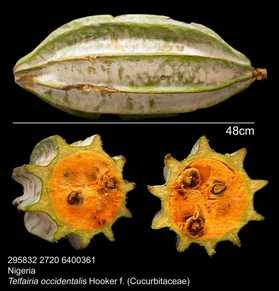 , one to few seeded. Pericarppericarp:
, one to few seeded. Pericarppericarp:
fruit wall or fruit coat
black, blue, purple, red, or orange, shinyshiny:
uniformly reflecting a high proportion of incident light at all angles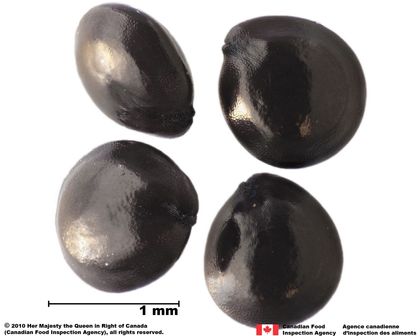 or dulldull:
or dulldull:
reflecting only a low proportion of incident light, with no apparent sheen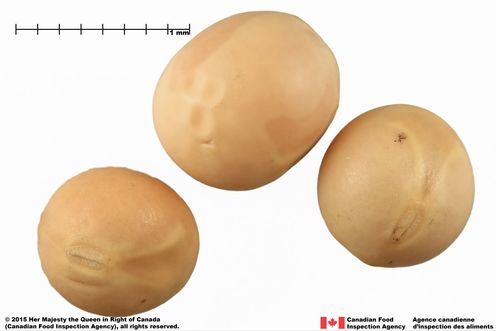 , sometimes with white powdery coating, fleshyfleshy:
, sometimes with white powdery coating, fleshyfleshy:
texture—fairly firm and dense, juicy or at least moist, and easily cut
or crustaceouscrustaceous:
texture—thin, dry, indurate, and brittle
, smooth.
Seed globoseglobose:
3D shape—more or less spherical
 to angularangular:
to angularangular:
2D shape—having sides that meet at acute or obtuse angles
, or lens-shapedlens-shaped:
2D shape—round and flattened with two curved (convex) surfaces
. Seed coat brown, yellow, gray to purple, shinyshiny:
uniformly reflecting a high proportion of incident light at all angles , membranousmembranous:
, membranousmembranous:
texture—extremely thin, pliable, and fairly tough
, smooth, pittedpitted:
surface relief—surface with small depressions in which the areas between the hollows do not take on the appearance of a true reticular net , wrinkledwrinkled:
, wrinkledwrinkled:
surface relief—shallow, irregular folds and furrows covering the surface; appearing overall though crumpled and then spread out , or groovedgrooved:
, or groovedgrooved:
surface relief—linear depressions that may be single or form a series of grooves over the surface .
.
Embryo minute, linearlinear:
(shape) long, narrow, and uniform in width; (of embryo) embryo is straight and much longer than wide
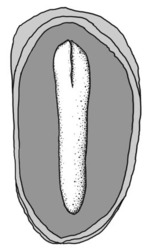 , straight, embedded in endospermendosperm:
, straight, embedded in endospermendosperm:
nutritive starch- and oil-containing tissue present in many seeds
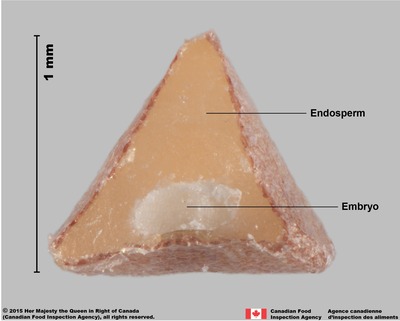 . Endospermendosperm:
. Endospermendosperm:
nutritive starch- and oil-containing tissue present in many seeds
 copious, cartilaginouscartilaginous:
copious, cartilaginouscartilaginous:
texture—firm, dense, tough, somewhat pliable, and resilient, like cartilage
or hard.
| Fruit | |
| Type | berryberry: an indehiscent, fleshy fruit with one or a few to many seeds. The flesh may be homogenous throughout. Or, if the outer part is hard, firm, or leathery, referred to as an hesperidium. Septa are present in some, and the seeds may be arillate or with a fleshy testa.  |
| Size range | 4–20 mm long |
| Shape(s) | globoseglobose: 3D shape—more or less spherical  |
| Texture | fleshy, crustaceous |
| Surface relief | smooth |
| Color(s) | black, blue, purple, red, orange, white |
| Unique features | Fleshy fleshy: texture—fairly firm and dense, juicy or at least moist, and easily cut or crustaceouscrustaceous: texture—thin, dry, indurate, and brittle , bright colored, globoseglobose: 3D shape—more or less spherical  berriesberries: berriesberries:an indehiscent, fleshy fruit with one or a few to many seeds. The flesh may be homogenous throughout. Or, if the outer part is hard, firm, or leathery, referred to as an hesperidium. Septa are present in some, and the seeds may be arillate or with a fleshy testa.  . . |
| Seed | |
| Shape(s) | globose, ovoidovoid: 3D shape—ovate  , polygonalpolygonal: , polygonalpolygonal:=angular , oblateoblate: depressed globose , lens-shaped |
| Surface relief | pitted, wrinkledwrinkled: surface relief—shallow, irregular folds and furrows covering the surface; appearing overall though crumpled and then spread out  , grooved , grooved |
| Color(s) | yellow, brown, gray, purple |
| Other | |
| Embryo | minute, linearlinear: (shape) long, narrow, and uniform in width; (of embryo) embryo is straight and much longer than wide  , straight, embedded in cartilaginouscartilaginous: , straight, embedded in cartilaginouscartilaginous:texture—firm, dense, tough, somewhat pliable, and resilient, like cartilage or hard endosperm |
| Nutritive tissuenutritive tissue: tissue within the seeds that nourishes the developing embryo; such as endosperm, perisperm, or chalazosperm in angiosperms; megagametophyte in gymnosperms |
endosperm endosperm: nutritive starch- and oil-containing tissue present in many seeds  copious, cartilaginouscartilaginous: copious, cartilaginouscartilaginous:texture—firm, dense, tough, somewhat pliable, and resilient, like cartilage or hard. |
Pantropical to temperate.
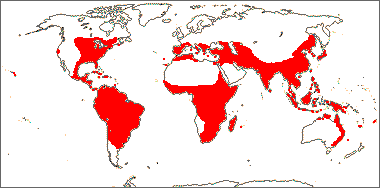
Distribution map courtesy of Angiosperm Phylogeny Website.
Baskin and Baskin 2021Baskin and Baskin 2021:
Baskin C and Baskin J. 2021. Relationship of the lateral embryo (in grasses) to other monocot embryos: A status up-grade. Seed Science Research 31 (3): 199-210. doi:10.1017/S0960258521000209; Cowley 1989Cowley 1989:
Cowley EJ. 1989. Smilacaceae. In: Polhill RM, ed. Flora of Tropical East Africa. Vol 172. AA Balkema, Rotterdam Netherlands. 4 pp.; Dahlgren et al. 1985Dahlgren et al. 1985:
Dahlgren RMT, Clifford HT, and Yeo PF. 1985. The families of the monocotyledons: structure, evolution, and taxonomy. Springer-Verlag, Berlin. 520 pp.; Flora of Australia 2021+Flora of Australia 2021+:
Flora of Australia. Australian Biological Resources Study, Canberra. Accessed January-May 2021. URL: http://www.ausflora.org.au; Kirkbride et al. 2006Kirkbride et al. 2006:
Kirkbride JH, Jr, Gunn CR, and Dallwitz MJ. 2006. Family guide for fruits and seeds, vers. 1.0. Accessed September 2020ndash;January 2022. URL: https://nt.ars-grin.gov/seedsfruits/keys/frsdfam/index.cfm .; Kubitzki et al. 1990+Kubitzki et al. 1990+:
Kubitzki K et al., eds. 1990+. The families and genera of vascular plants. 7+ vols. Berlin etc.; Martin 1946Martin 1946:
Martin AC. 1946. The comparative internal morphology of seeds. American Midland Naturalist 36 (3): 513ndash;660. https://doi.org/10.2307/2421457; Stevenson and Loconte 1995Stevenson and Loconte 1995:
Stevenson DW and Loconte H. 1995. A cladistic analysis of monocot families. In: Rudall PJ, Cribb PJ, Cutler DF, and Humphries CJ, eds. Monocotyledons: Systematics and Evolution. Royal Botanic Gardens, Kew.; Takhtajan 2009Takhtajan 2009:
Takhtajan A. 2009. Flowering plants: Second edition. Springer Nature, Switzerland. 871 pp.; Zhengyi et al. 2004+Zhengyi et al. 2004+:
Zhengyi W, Raven PH, and Deyuan H. 2004+. Flora of China [online]. 25 vols. Science Press, Beijing China amp; Missouri Botanical Garden, St. Louis USA. Accessed January-December 2021. http://flora.huh.harvard.edu/china/
*The number of genera and species is based on Christenhusz and Byng 2016Christenhusz and Byng 2016:
Christenhusz MJM and Byng JW. 2016. The number of known plant species in the world and its annual increase. Phytotaxa 261 (3): 201ndash;217. https://doi.org/10.11646/phytotaxa.261.3.1, which may differ from the number of genera in GRIN-Global.